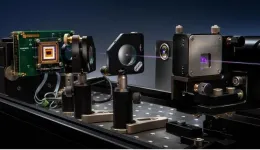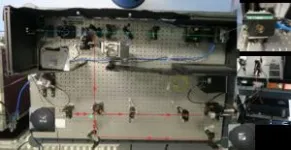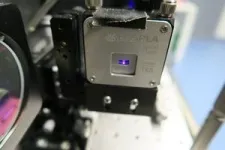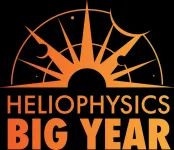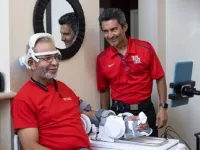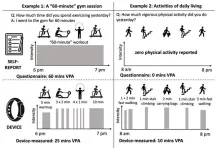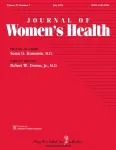(Press-News.org) WASHINGTON — Researchers have reported the first 3D measurements acquired with quantum ghost imaging. The new technique enables 3D imaging on a single photon level, yielding the lowest photon dose possible for any measurement.
“3D imaging with single photons could be used for various biomedical applications, such as eye care diagnostics,” said researcher Carsten Pitsch from the Fraunhofer Institute of Optronics, System Technologies and Image Exploitation and Karlsruhe Institute of Technology, both in Germany. “It can be applied to image materials and tissues that are sensitive to light or drugs that become toxic when exposed to light without any risk of damage.”
In the Optica Publishing Group journal Applied Optics, the researchers describe their new approach, which incorporates new single photon avalanche diode (SPAD) array detectors. They apply the new imaging scheme, which they call asynchronous detection, to perform 3D imaging with quantum ghost imaging.
“Asynchronous detection might also be useful for military or security applications since it could be used to observe without being detected while also reducing the effects of over-illumination, turbulence and scattering,” said Pitsch. “We also want to investigate its use in hyperspectral imaging, which could allow multiple spectral regions to be recorded simultaneously while using a very low photon dose. This could be very useful for biological analysis.”
Adding a third dimension
Quantum ghost imaging creates images using entangled photon-pairs in which only one member of the photon pair interacts with the object. The detection time for each photon is then used to identify entangled pairs, which allows an image to be reconstructed. This approach not only allows imaging at extremely low light levels but also means that the objects being imaged do not have to interact with the photons used for imaging.
Previous setups for quantum ghost imaging were not capable of 3D imaging because they relied on intensified charge-coupled device (ICCD) cameras. Although these cameras have good spatial resolution, they are time-gated and don’t allow the independent temporal detection of single photons.
To solve this problem, the researchers developed a setup based on new single photon avalanche diode (SPAD) arrays developed for LiDAR and medical imaging. These detectors have multiple independent pixels with dedicated timing circuitry, which allows them to record the detection time of every pixel with picosecond resolution.
The new approach uses two entangled photons — a signal and an idler — to obtain 3D images with single photon illumination. This involves directing the idler photons onto the object and then detecting the backscattered photons in time. Meanwhile, the signal photons are directed to a dedicated camera that detects as many photons as possible in both time and space. The researchers then compared the time of detection of every pixel with the detection of the single-pixel detector to reconstruct the entanglement. This also allowed them to determine the time of flight of the interacting idler photons, and with that, the depth of the object.
An adaptable setup
Another key innovation was periodic poling of the KTP crystal used to create the entangled photons. “This allows highly efficient quasi-phase matching for nearly any triplet of pump-signal-idler and lets us freely choose the wavelengths for illumination and imaging,” said Pitsch. “It also lets us adapt the setup to many other applications or wavelengths.”
The researchers demonstrated the 3D capabilities of their asynchronous detection scheme using two different separate setups. One, which resembled a Michelson interferometer, acquired images using two spatially separated arms. This setup allowed the researchers to analyze the SPAD performance and improve the coincidence detection. The other setup used free-space optics and was more application centered. Instead of imaging with two separated arms, two objects in the same arm were imaged.
Although more work is needed, both setups worked well as a proof-of-concept demonstration for the new technique. The experiments also showed that asynchronous detection could be used for remote detection, which could be useful for atmospheric measurements.
The researchers are now working with a SPAD manufacturer to increase the spatial resolution and duty cycle – the percentage of time the detector is on – for the SPAD cameras. They also plan to replace the fiber-coupled idler detector with a faster free-space coupled detector that became available recently. Finally, they plan to apply the setup to hyperspectral imaging, which could be used to perform imaging in the important mid-infrared spectrum without the need for detectors that work at these wavelengths.
Paper: C. Pitsch, D. Walter, L. Gasparini, H. Bursing, M. Eichhorn, “3D Quantum Ghost Imaging,” Applied Optics, vol. 62, issue 23, pp. 6275-6281 (2023).
DOI: doi.org/10.1364/AO.492208
About Applied Optics
Applied Optics publishes in-depth peer-reviewed content about applications-centered research in optics. These articles cover research in optical technology, photonics, lasers, information processing, sensing and environmental optics. Applied Optics is published three times per month by Optica Publishing Group and overseen by Editor-in-Chief Gisele Bennett, MEPSS LLC and Georgia Institute of Technology, USA. For more information, visit Applied Optics.
About Optica
Optica Publishing Group is a division of Optica (formerly OSA), Advancing Optics and Photonics Worldwide. It publishes the largest collection of peer-reviewed content in optics and photonics, including 18 prestigious journals, the society’s flagship member magazine, and papers from more than 835 conferences, including 6,500+ associated videos. With over 400,000 journal articles, conference papers and videos to search, discover and access, Optica Publishing Group represents the full range of research in the field from around the globe.
END
Researchers use SPAD detector to achieve 3D quantum ghost imaging
Single-photon imaging technique could be useful for biomedical and security applications
2023-08-08
ELSE PRESS RELEASES FROM THIS DATE:
NASA announces monthly themes to celebrate the Heliophysics Big Year
2023-08-08
This October, NASA is launching the Heliophysics Big Year – a global celebration of solar science and the Sun’s influence on Earth and the entire solar system. Modeled after the “Big Year” concept from citizen scientists in the bird-watching community, the Heliophysics Big Year challenges everyone to get involved with fun Sun-related activities.
For each month from October 2023 to December 2024, the Heliophysics Big Year will celebrate under a theme, sharing opportunities to participate in many solar science events from watching eclipses to joining citizen science projects. During ...
Stroke rehab at home is near
2023-08-08
The world of at-home stroke rehabilitation is growing near, incredible news for the 795,000 people in the United States who annually suffer a stroke. A new low cost, portable brain-computer interface that connects the brain of stroke patients to powered exoskeletons for rehabilitation purposes has been validated and tested at the University of Houston.
“We designed and validated a wireless, easy-to-use, mobile, dry-electrode headset for scalp electroencephalography (EEG) recordings for closed-loop brain–computer ...
People’s everyday pleasures may improve cognitive arousal and performance
2023-08-08
Listening to music and drinking coffee are the sorts of everyday pleasures that can impact a person’s brain activity in ways that improve cognitive performance, including in tasks requiring concentration and memory.
That’s a finding of a new NYU Tandon School of Engineering study involving MINDWATCH, a groundbreaking brain-monitoring technology.
Developed over the past six years by NYU Tandon's Biomedical Engineering Associate Professor Rose Faghih, MINDWATCH is an algorithm that analyzes a person's brain activity from data collected via any wearable device that can monitor electrodermal activity ...
Nitrogen runoff strategies complicated by climate change
2023-08-08
Washington, DC— As climate change progresses, rising temperatures may impact nitrogen runoff from land to lakes and streams more than projected increases in total and extreme precipitation for most of the continental United States, according to new research from a team of Carnegie climate scientists led by Gang Zhao and Anna Michalak published in the Proceedings of the National Academy of Sciences.
The conditions predicted by these findings are opposite to recent decades, when increasing precipitation has outpaced warming and led to more aquatic nitrogen pollution. Understanding the relative roles of changes in temperature and rainfall is critical for designing ...
Wearables will transform health, but change brings challenges say researchers
2023-08-08
In a series of three editorials published in the British Journal of Sports Medicine, the international team of scientists discuss issues facing the wearables field including lack of standardisation of devices and data, disconnects between research and industry and the impact of inequality in ownership.
Currently around a third of UK adults own a smartwatch or fitness tracker. A 2021 Australian-based survey reported 24 percent used fitness trackers and 23 percent used smartwatches.
Some use them to track their steps, others their sleep, but few understand the potential of these devices to transform our understanding of how everyday activity influences health.
“If you ...
Meet the Persian Gold Tarantula: a new species discovery just on time for Tarantula Appreciation Day 2023
2023-08-08
The Persian Gold Tarantula (Chaetopelma persianum) is a newly described species recently discovered in northwestern Iran. In fact, the “woolly, golden hairs” the scientists observed and examined on a single specimen, were one of the features so unique that it was not necessary for additional individuals to be collected and physically studied. It was clear enough that it was a species previously unknown to the scientific community.
The paper, authored by Iranian arachnologist and taxonomist Dr Alireza Zamani (University of Turku, Finland) and his Canadian colleague Rick C. West, was published in the peer-reviewed, open-access scientific journal ZooKeys on the observance ...
Poor time management causes poor sleep for college students
2023-08-08
TUSCALOOSA, Ala. – A lack of time management skills, particularly in organization, can lead to poor sleep quality for college students according to research conducted at The University of Alabama.
Dr. Adam Knowlden, associate professor of health science with the UA College of Human Environmental Sciences, investigated time management and how it influences sleep health in full-time college students in the areas of setting goals and priorities, mechanics of time management, and preference for organization.
“College students tend to deal with lifestyle-related sleep problems,” said Knowlden. “For example, balancing academic and social ...
Menstrual equity in the criminal legal system
2023-08-08
A new study has shown that among incarcerated women, many have to trade or barter to access menstrual hygiene products. The study, which examines menstrual equity, or the access to menstrual products and safe menstruating environments, in the criminal legal system, is published in the peer-reviewed Journal of Women’s Health. Click here to read the article now.
Patricia Kelly, PhD, from Thomas Jefferson University School of Nursing, and coauthors, found that 53.8% of women involved in the criminal legal system received less than five menstrual ...
From bench to bedside: patient with Duchenne muscular dystrophy receives first dose of gene therapy developed at Nationwide Children’s Hospital
2023-08-08
(COLUMBUS, Ohio) – In a landmark moment for the Abigail Wexner Research Institute at Nationwide Children’s, a 5-year-old from Bellefontaine, Ohio, received the first dose of a recently approved gene therapy for Duchenne muscular dystrophy at Nationwide Children’s Hospital, where the therapy was invented and initially tested. The therapy, developed, tested and patented at Nationwide Children’s marks an extraordinary achievement in the field of neuromuscular medicine and provides a life-altering treatment for children with Duchenne muscular dystrophy. This is the second gene therapy developed at Nationwide Children’s to receive FDA approval, two ...
Scientists spurred by a thirst to transform the field of phytoplankton forecasting
2023-08-08
Safe drinking water is threatened globally by the increased toxicity of phytoplankton — or microscopic algae — blooms.
The need for a better understanding of when and where the blooms will emerge spurred Virginia Tech researchers to start developing the first automated, real-time lake phytoplankton forecasting system. Working with the University of Florida, Virginia Tech faculty have been awarded a $2.2 million National Science Foundation grant as one of 12 projects funded by the foundation's new Using the Rules of Life to Address Societal Challenges program.
"The enormous opportunity to apply biological principles to ...
LAST 30 PRESS RELEASES:
Low daily alcohol intake linked to 50% heightened mouth cancer risk in India
American Meteorological Society announces Rick Spinrad as 2026 President-Elect
Biomass-based carbon capture spotlighted in newly released global climate webinar recording
Illuminating invisible nano pollutants: advanced bioimaging tracks the full journey of emerging nanoscale contaminants in living systems
How does age affect recovery from spinal cord injury?
Novel AI tool offers prognosis for patients with head and neck cancer
Fathers’ microplastic exposure tied to their children’s metabolic problems
Research validates laboratory model for studying high-grade serous ovarian cancer
SIR 2026 delivers transformative breakthroughs in minimally invasive medicine to improve patient care
Stem Cell Reports most downloaded papers of 2025 highlight the breadth and impact of stem cell research
Oxford-led study estimates NHS spends around 3% of its primary and secondary care budget on the health impacts of heat and cold in England
A researcher’s long quest leads to a smart composite breakthrough
Urban wild bees act as “microbial sensors” of city health.
New study finds where you live affects recovery after a hip fracture
Forecasting the impact of fully automated vehicle adoption on US road traffic injuries
Alcohol-related hospitalizations from 2016 to 2022
Semaglutide and hospitalizations in patients with obesity and established cardiovascular disease
Researchers ‘listen in’ to embryo-mother interactions during implantation using a culture system replicating the womb lining
How changing your diet could help save the world
How to make AI truly scalable and reliable for real-time traffic assignment?
Beyond fragmented markets: A new framework for efficient and stable ride-pooling
Can shape priors make road perception more reliable for autonomous driving?
AI tracks nearly 100 years of aging research, revealing key trends and gaps
Innovative techniques enable Italy’s first imaging of individual trapped atoms
KIER successfully develops Korea-made “calibration thermoelectric module” for measuring thermoelectric device performance
Diversifying US Midwest farming for stability and resilience
Emphasizing immigrants’ deservingness shifts attitudes
Japanese eels, climate change, and river temperature
Pusan National University researchers discover faster, smarter heat treatment for lightweight magnesium metals
China’s 2024 Gastroenterology Report: marked progress in endoscopy quality and disease management
[Press-News.org] Researchers use SPAD detector to achieve 3D quantum ghost imagingSingle-photon imaging technique could be useful for biomedical and security applications
